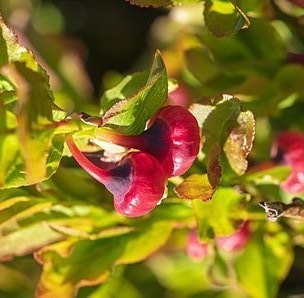Bilberry
(Vaccinium ovalifolium)

Description
Vaccinium myrtillus or European blueberry is a holarctic species of shrub with edible fruit of blue color, known by the common names bilberry, blaeberry, wimberry, and whortleberry. It is more precisely called common bilberry or blue whortleberry, to distinguish it from other Vaccinium relatives. Regional names include blaeberry (Scotland & Northern England), urts or hurts (Cornwall & Devon), hurtleberry, huckleberry, myrtleberry, wimberry, whinberry, winberry, blueberry, and fraughan.Chromosome count is 2n =24. Vaccinium myrtillus has much in common with the American blueberry (Vaccinium corymbosum). Vaccinium myrtillus is a holarctic species native to Continental Northern Europe, the British Isles and Ireland, northern Asia, Japan, Greenland, Iceland, Western Canada, and the Western United States. It occurs in the acidic soils of heaths, boggy barrens, degraded meadows, open forests and parklands, hummocky seepage slopes, and moraines. Vaccinium myrtillus has been used for nearly 1,000 years in traditional European medicine. Vaccinium myrtillus fruits have been used in traditional Austrian medicine internally (directly or as tea or liqueur) for treatment of disorders of the gastrointestinal tract and diabetes. Herbal supplements of V. myrtillus (bilberry) on the market are used for cardiovascular conditions, diabetes, as vision aids, and to treat diarrhea and other conditions. Researchers are interested in bilberry because of its high concentrations of anthocyanins, which may have various health benefits. The United States' National Institutes of Health (NIH) cautions, "There's not enough scientific evidence to support the use of bilberry for any health conditions. In cooking, the bilberry fruit is commonly used for the same purposes as the American blueberry, such as filling for pies, tarts and flans, cakes, jams, muffins, cookies, sauces, syrups, juices, and candies. In traditional medicine, bilberry leaf is used for different conditions, including diarrhea, scurvy, infections, burns, and diabetes. Since many people refer to "blueberries" whether they intend to refer to the bilberry (European blueberry) Vaccinium myrtillus or the American blueberries Vaccinium corymbosum, there is confusion about the two closely similar fruits. For instance, in the Scandinavian languages, Vaccinium myrtillus and other bilberries are called blåbär (or blåbær), which literally means blueberry.
Taxonomic tree:







